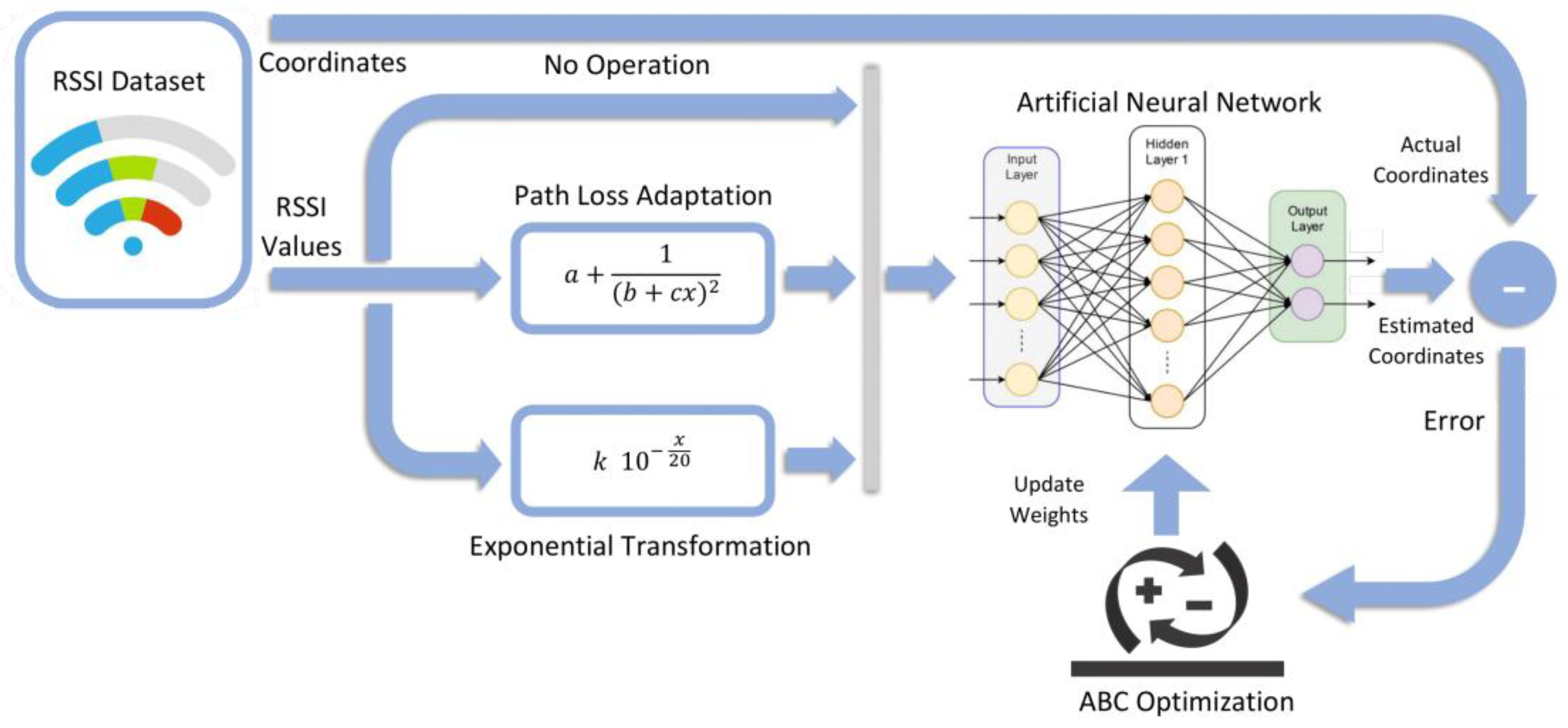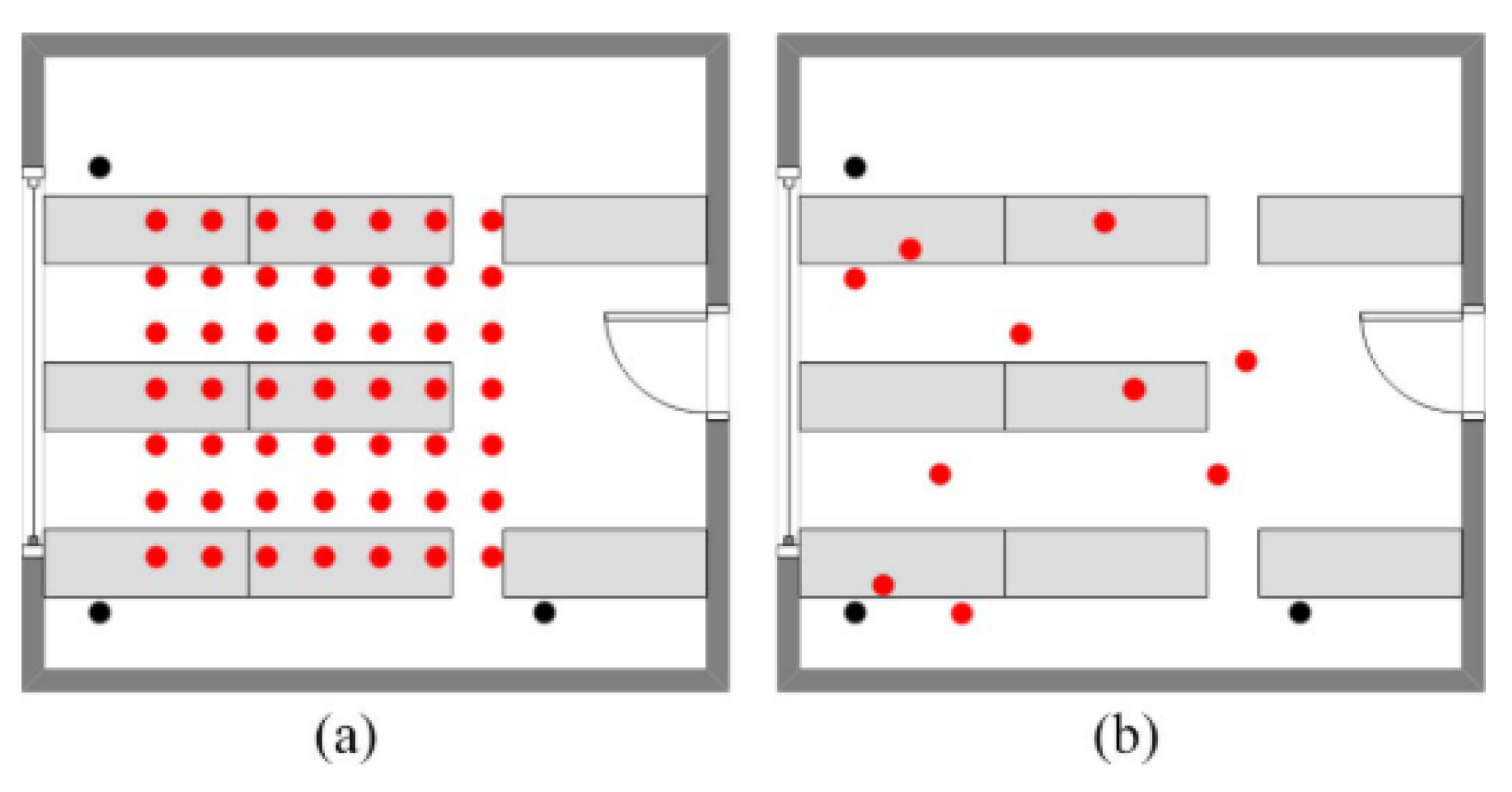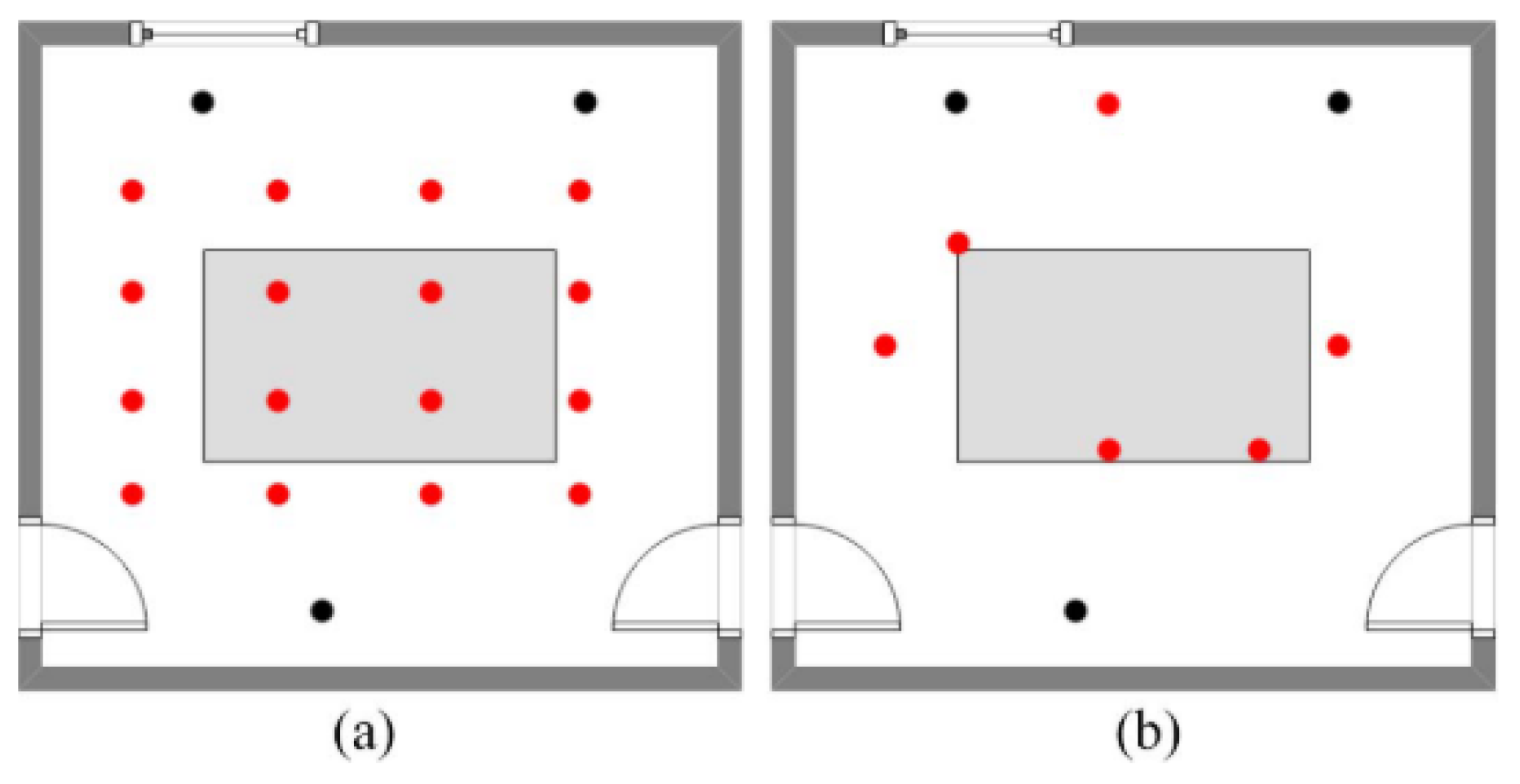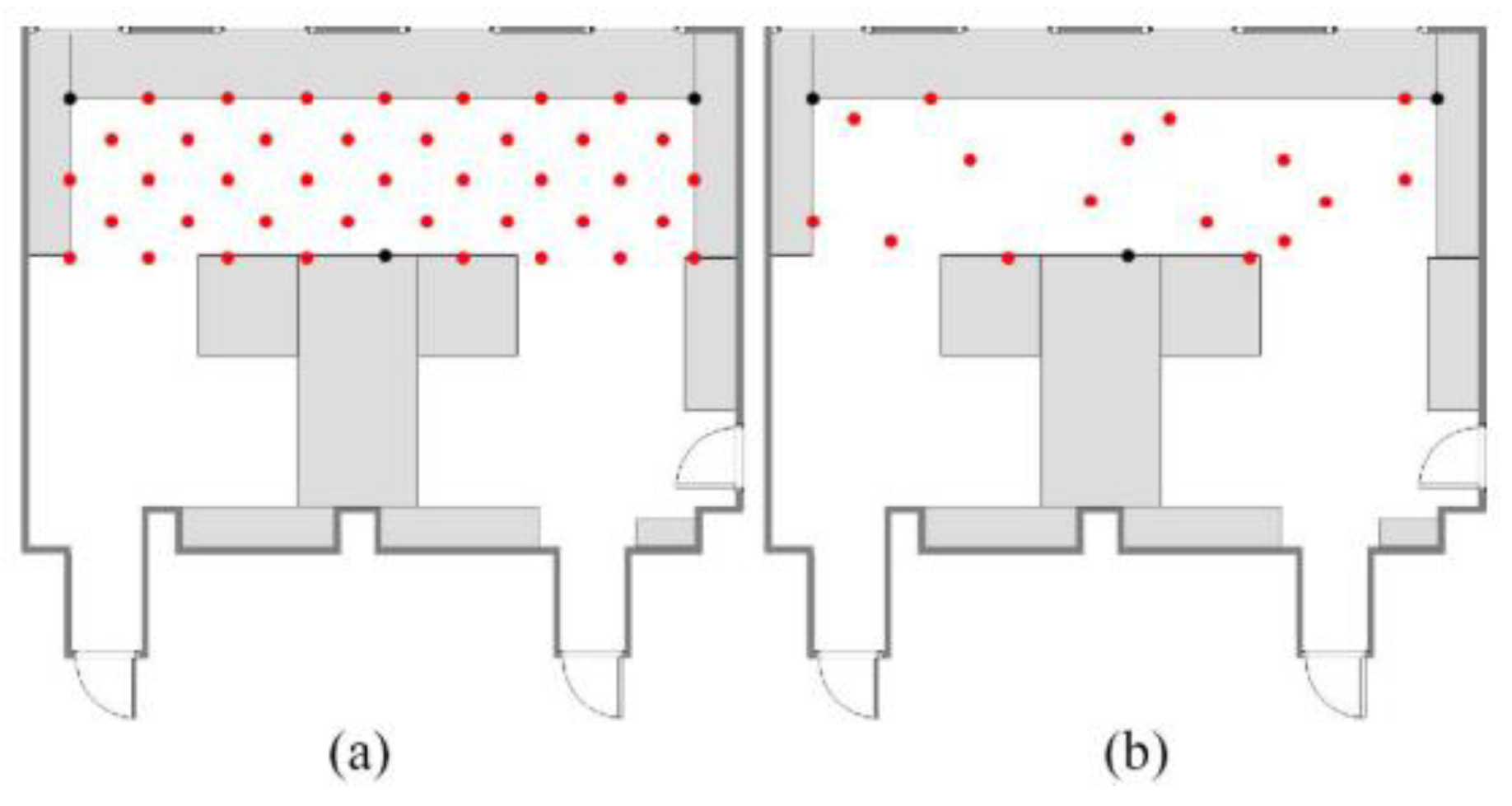ABC-ANN Based Indoor Position Estimation Using Preprocessed RSSI
Abstract
1. Introduction
2. Literature Review
3. Materials and Methods
3.1. Preprocessing of Raw RSSI Values
3.2. ANN Structure Determination Approach
- Initially, both first and second layers’ activation function is determined as tangent sigmoid function.
- Then, the number of neurons in the second hidden layer is fixed to 10.
- Afterwards, the number of neurons in the first hidden layer is gradually increased from 1 to 40.
- This search process is repeated by changing the first hidden layer activation function.
- The parameters determined as the best result of this scanning process are fixed for the first layer.
- The same search process is repeated for the second hidden layer.
- When the search process is completed for the second hidden layer, the best parameters are fixed for the second hidden layer again.
- Next, the process repeats for the first layer.
- When the parameters for both layers do not change or begin to change around the same numbers, the search process is terminated.
3.3. Adaptation of Artificial Bee Colony for ANN Training
- i.
- Number of weights between input layer and hidden layer
- ii.
- Number of biases in hidden layer
- iii.
- Number of weights between hidden layer and output layer
- iv.
- Number of biases in output layer
3.4. Other Machine Learning Methods
4. Results and Discussion
5. Conclusions
Funding
Data Availability Statement
Conflicts of Interest
References
- Global Positioning System Standard Positioning Service Performance Standard; by John G. Grimes in 2008. Available online: https://rosap.ntl.bts.gov/view/dot/16930 (accessed on 5 November 2021).
- Chen, J.; Song, S.; Yu, H. An indoor multi-source fusion positioning approach based on PDR/MM/WiFi. AEU-Int. J. Electron. Commun. 2021, 135, 153733. [Google Scholar] [CrossRef]
- Khudhuragha, M. Indoor Location Estimation Through Redundant Lateration for Indoor Positioning System. Master of Science Thesis, Kadir Has University, Istanbul, Turkey, 2017. Available online: https://acikbilim.yok.gov.tr/handle/20.500.12812/638391 (accessed on 6 November 2022).
- Park, M.; Han, J.H.; Kim, O.J.; Kim, J.; Kee, C. One-way deep indoor positioning system for conventional GNSS receiver using paired transmitters. Navig. J. Inst. Navig. 2021, 68, 601–619. [Google Scholar] [CrossRef]
- Ijaz, F.; Yang, H.K.; Ahmad, A.W.; Lee, C. Indoor positioning: A review of indoor ultrasonic positioning systems. In Proceedings of the International Conference on Advanced Communication Technology, ICACT, PyeongChang, Korea, 27–30 January 2013; pp. 1146–1150. [Google Scholar]
- Chen, Y.; Liu, J.; Jaakkola, A.; Hyyppä, J.; Chen, L.; Hyyppä, H.; Jian, T.; Chen, R. Knowledge-based indoor positioning based on LiDAR aided multiple sensors system for UGVs. In Proceedings of the 2014 IEEE/ION Position, Location and Navigation Symposium—PLANS 2014, Monterey, CA, USA, 5–8 May 2014; pp. 109–114. [Google Scholar]
- Weyand, T.; Kostrikov, I.; Philbin, J. PlaNet—Photo geolocation with convolutional neural networks. In Proceedings of the European Conference on Computer Vision; Springer Verlag: Amsterdam, The Netherlands, 2016; pp. 37–55. [Google Scholar]
- Kahe, G.; Masoumi Ganjgah, F. MAKAN: A low-cost low-complexity local positioning system. Navig. J. Inst. Navig. 2019, 66, 401–415. [Google Scholar] [CrossRef]
- Zhang, Y.; Lu, L.; Wang, Y.; Chen, C. WLAN indoor localization method using angle estimation. AEU-Int. J. Electron. Commun. 2017, 76, 11–17. [Google Scholar] [CrossRef]
- Maduskar, D.; Tapaswi, S. RSSI based adaptive indoor location tracker. Sci. Phone Apps Mob. Devices 2017, 3, 1–8. [Google Scholar] [CrossRef]
- Papamanthou, C.; Preparata, F.P.; Tamassia, R. Algorithms for location estimation based on RSSI sampling. In Proceedings of the International Symposium on Algorithms and Experiments for Sensor Systems, Wireless Networks and Distributed Robotics, Reykjavik, Iceland, 12 July 2008; pp. 72–86. [Google Scholar]
- Saxena, M.; Gupta, P.; Jain, B.N. Experimental analysis of RSSI-based location estimation in wireless sensor networks. In Proceedings of the 3rd IEEE/Create-Net International Conference on Communication System Software and Middleware, COMSWARE, Bangalore, India, 6–10 January 2008; pp. 503–510. [Google Scholar]
- Paul, A.S.; Wan, E.A. RSSI-Based indoor localization and tracking using sigma-point kalman smoothers. IEEE J. Sel. Top. Signal Process. 2009, 3, 860–873. [Google Scholar] [CrossRef]
- Kul, G.; Özyer, T.; Tavli, B. IEEE 802.11 WLAN based real time indoor positioning: Literature survey and experimental investigations. Procedia Comput. Sci. 2014, 34, 157–164. [Google Scholar] [CrossRef]
- Dogan, M. Indoor Localization and Tracking Based on RSSI and Accelerometer Measurements. Master of Science Thesis, Middle East Technical University, Ankara, Turkey, 2015. Available online: https://open.metu.edu.tr/handle/11511/25283 (accessed on 2 November 2022).
- Alvarez, Y.; Las Heras, F. ZigBee-based Sensor Network for Indoor Location and Tracking Applications. IEEE Lat. Am. Trans. 2016, 14, 3208–3214. [Google Scholar] [CrossRef]
- Li, G.; Geng, E.; Ye, Z.; Xu, Y.; Lin, J.; Pang, Y. Indoor positioning algorithm based on the improved RSSI distance model. Sensors 2018, 18, 2820. [Google Scholar] [CrossRef]
- Dari, Y.E.; Suyoto, S.; Pranowo, P. CAPTURE: A mobile based indoor positioning system using wireless indoor positioning system. Int. J. Interact. Mob. Technol. 2018, 12, 61–72. [Google Scholar] [CrossRef][Green Version]
- Landa, V.; Ben-Moshe, B.; Hacohen, S.; Shvalb, N. GoIn—An accurate 3D indoor navigation framework based on light landmarks. Navig. J. Inst. Navig. 2019, 66, 633–642. [Google Scholar] [CrossRef]
- Chai, S.; An, R.; Du, Z. An Indoor Positioning Algorithm using Bluetooth Low Energy RSSI. In Proceedings of the The 2016 International Conference on Advanced Materials Science and Environmental Engineering; Atlantis Press: Chiang Mai, Thailand, 2016; pp. 276–278. [Google Scholar]
- Sadowski, S.; Spachos, P.; Plataniotis, K.N. Memoryless Techniques and Wireless Technologies for Indoor Localization with the Internet of Things. IEEE Internet Things J. 2020, 7, 10996–11005. [Google Scholar] [CrossRef]
- Ravi, A.; Misra, A. Practical server-side WiFi-based indoor localization: Addressing cardinality & outlier challenges for improved occupancy estimation. Ad Hoc Netw. 2021, 115, 102443. [Google Scholar]
- Ann, A.G.C.; Foong, S.; Ahmed, A.; Soh, G.S. Adapting the Boerdijk–Coxeter helix as node configuration for GPS-denied localization in three dimensions. Navig. J. Inst. Navig. 2021, 68, 485–506. [Google Scholar] [CrossRef]
- Zheng, J.; Li, K.; Zhang, X.; Zheng, J.; Li, K.; Zhang, X. Wi-Fi Fingerprint-Based Indoor Localization Method via Standard Particle Swarm Optimization. Sensors 2022, 22, 5051. [Google Scholar] [CrossRef] [PubMed]
- Zhou, M.; Long, Y.; Zhang, W.; Pu, Q.; Wang, Y.; Nie, W.; He, W. Adaptive Genetic Algorithm-Aided Neural Network With Channel State Information Tensor Decomposition for Indoor Localization. IEEE Trans. Evol. Comput. 2021, 25, 913–927. [Google Scholar] [CrossRef]
- Angrisani, L.; Fotiou, N.; Butun, I.; Yoo, J. Multiple Fingerprinting Localization by an Artificial Neural Network. Sensors 2022, 22, 7505. [Google Scholar]
- Hou, C.; Xie, Y.; Zhang, Z. An improved convolutional neural network based indoor localization by using Jenks natural breaks algorithm. China Commun. 2022, 19, 291–301. [Google Scholar] [CrossRef]
- Sauter, M. From GSM to LTE: An Introduction to Mobile Networks and Mobile Broadband; Wiley: Ravensburg, Germany, 2011. [Google Scholar]
- Srinivasan, K.; Levis, P. RSSI is Under Appreciated. In Proceedings of the Third Workshop on Embedded Networked Sensors (EmNets), Cambridge, MA, USA, 30–31 May 2006; pp. 239–242. [Google Scholar]
- Shi, W.; Du, J.; Cao, X.; Yu, Y.; Cao, Y.; Yan, S.; Ni, C. IKULDAS: An Improved kNN-Based UHF RFID Indoor Localization Algorithm for Directional Radiation Scenario. Sensors 2019, 19, 968. [Google Scholar] [CrossRef]
- Jiang, J.R.; Liao, J.H. Efficient Wireless Charger Deployment for Wireless Rechargeable Sensor Networks. Energies 2016, 9, 696. [Google Scholar] [CrossRef]
- Kandiri, A.; Mohammadi Golafshani, E.; Behnood, A. Estimation of the compressive strength of concretes containing ground granulated blast furnace slag using hybridized multi-objective ANN and salp swarm algorithm. Constr. Build. Mater. 2020, 248, 118676. [Google Scholar] [CrossRef]
- Ustun, D.; Balci, S.; Sabanci, K. A parametric simulation of the wireless power transfer with inductive coupling for electric vehicles, and modelling with artificial bee colony algorithm. Meas. J. Int. Meas. Confed. 2020, 150, 107082. [Google Scholar] [CrossRef]
- Gultekin, S.S.; Uzer, D.; Dundar, O. Calculation of circular microstrip antenna parameters with a single artificial neural network model. In Proceedings of the Progress in Electromagnetics Research Symposium, Kuala Lumpur, Malaysia, 27–30 March 2012; pp. 545–548. [Google Scholar]
- Singh, R.; Kainthola, A.; Singh, T.N. Estimation of elastic constant of rocks using an ANFIS approach. Appl. Soft Comput. 2012, 12, 40–45. [Google Scholar] [CrossRef]
- Yelken, E.; Uzer, D. Artificial Neural Network Model with Firefly Algorithm for Seljuk Star Shaped Microstrip Antenna. Eur. J. Sci. Technol. 2020, 251–256. [Google Scholar] [CrossRef]
- Sabanci, K.; Aydin, N.; Sayaslan, A.; Sonmez, M.E.; Fatih Aslan, M.; Demir, L.; Sermet, C. Wheat Flour Milling Yield Estimation Based on Wheat Kernel Physical Properties Using Artificial Neural Networks. Int. J. Intell. Syst. Appl. Eng. 2020, 8, 78–83. [Google Scholar] [CrossRef]
- Graupe, D. Principles of Artificial Neural Networks, 2nd ed.; World Scientific Publishing Company: Chicago, IL, USA, 2006; ISBN 9789812706249. [Google Scholar]
- Karaboga, D.; Akay, B. A comparative study of Artificial Bee Colony algorithm. Appl. Math. Comput. 2009, 214, 108–132. [Google Scholar] [CrossRef]
- Ozturk, C.; Karaboga, D. Hybrid Artificial Bee Colony algorithm for neural network training. In Proceedings of the 2011 IEEE Congress of Evolutionary Computation, CEC, New Orleans, LA, USA, 5–8 June 2011; pp. 84–88. [Google Scholar]
- Unlersen, M.F. FPGA Kullanılarak Dizi Anten Performansının Iyileştirilmesi—Improving of Array Antenna Performance Using FPGA; Institute of Science and Technology—Electrical and Electronics Engineering Department. Selcuk University: Konya, Turkey, 2015. [Google Scholar]
- Nagy, Z.; Werner-Stark, Á.; Dulai, T. An Artificial Bee Colony Algorithm for Static and Dynamic Capacitated Arc Routing Problems. Mathematics 2022, 10, 2205. [Google Scholar] [CrossRef]
- Yu, H. Network complexity analysis of multilayer feedforward artificial neural networks. In Book Cover Book Cover Applications of Neural Networks in High Assurance Systems; Schumann Johann, L.Y., Ed.; Springer: Berlin/Heidelberg, Germany, 2010; pp. 41–55. [Google Scholar]
- Russell, S.J.; Stuart, J.; Norvig, P.; Davis, E. Artificial Intelligence: A Modern Approach; Prentice Hall: Hoboken, NJ, USA, 2010; ISBN 0136042597. [Google Scholar]
- Lux Luna Computational Complexity Of Neural Networks. Available online: https://lunalux.io/computational-complexity-of-neural-networks/ (accessed on 5 November 2022).
- Kon Mark, A.P.L. Complexity of Predictive Neural Networks. In Proceedings of the International Conference on Complex Systems; New England Complex Systems Institue, Nashua, NH, USA, 21–26 May 2000; pp. 1–8. [Google Scholar]
- Weka 3: Data Mining Software in Java 2018. 2018. Available online: https://www.cs.waikato.ac.nz/ml/weka/ (accessed on 23 March 2022).
- Koklu, M.; Sabanci, K.; Unlersen, M.F. Classification of Heuristic Information by Using Machine Learning Algorithms. Int. J. Intell. Syst. Appl. Eng. 2016, 4, 252–254. [Google Scholar] [CrossRef]
- Witten, I.H.; Frank, E.; Hall, M.A.; Pal, C.J. Data Mining: Practical Machine Learning Tools and Techniques; Elsevier Inc.: Amsterdam, The Netherlands, 2016; pp. 1–621. ISBN 9780128042915. [Google Scholar]
- Rasmussen, C.E.; Williams, C.K.I. Gaussian Processes for Machine Learning; The MIT Press: Cambridge, MA, USA; London, UK, 2006; pp. 715–719. ISBN 026218253X. [Google Scholar]
- Wang, J. An Intuitive Tutorial to Gaussian Processes Regression; Queen’s University: Kingston, ON, Canada, 2021. [Google Scholar]
- Huang, C.-L.; Liao, H.-C.; Chen, M.-C. Prediction model building and feature selection with support vector machines in breast cancer diagnosis. Expert Syst. Appl. 2008, 34, 578–587. [Google Scholar] [CrossRef]
- Cortes, C.; Vapnik, V. Support-Vector Networks. Mach. Learn. 1995, 20, 273–297. [Google Scholar] [CrossRef]







| # | Scenario | X | Y | RSSI A | RSSI B | RSSI C |
|---|---|---|---|---|---|---|
| 1 | Scenario 1 | 1.00 m | 0.50 m | −58 dBm | −57 dBm | −62 dBm |
| 2 | Scenario 1 | 1.50 m | 2.00 m | −52 dBm | −60 dBm | −61 dBm |
| 3 | Scenario 2 | 0.65 m | 0.78 m | −40 dBm | −42 dBm | −45 dBm |
| 4 | Scenario 2 | 3.27 m | 2.56 m | −43 dBm | −45 dBm | −37 dBm |
| 5 | Scenario 3 | 0.60 m | 0.62 m | −31 dBm | −43 dBm | −48 dBm |
| 6 | Scenario 3 | 3.00 m | 1.87 m | −32 dBm | −38 dBm | −39 dBm |
| Training Data Set (pcs) | Testing Data Set (pcs) | |
|---|---|---|
| Scenario 1 | 49 | 10 |
| Scenario 2 | 16 | 6 |
| Scenario 3 | 40 | 16 |
| Total | 105 | 32 |
| Raw Data Set | Path Loss Adapted Data Set | Exponential Transformed Data Set | ||
|---|---|---|---|---|
| X-axis | Activation function | Tangent Sigmoid | Tangent Sigmoid | Tangent Sigmoid |
| Number of neurons | 19 | 4 | 24 | |
| Y-axis | Activation function | Tangent Sigmoid | Tangent Sigmoid | Tangent Sigmoid |
| Number of neurons | 19 | 5 | 26 |
| Raw Data Set (pcs) | Path Loss Adapted Data Set (pcs) | Exponential Transformed Data Set (pcs) | |
|---|---|---|---|
| X-axis | 96 | 21 | 121 |
| Y-axis | 96 | 26 | 131 |
| The Results in Reference [21] | Raw Data Set | Path Loss Adapted Data Set | Exponential Converted Data Set | |
|---|---|---|---|---|
| Scenario 1 | 1.8303 m | 1.5844 m | 1.0528 m | 1.4405 m |
| Scenario 2 | 1.4147 m | 0.8153 m | 0.8035 m | 1.1245 m |
| Scenario 3 | 1.3856 m | 1.3064 m | 1.1865 m | 1.3869 m |
| Average | 1.6020 m | 1.2824 m | 1.0729 m | 1.3544 m |
| PreProcess | Gaussian Processes (m) | Linear Regression (m) | SVM (m) | k-NN (m) | Random Forest (m) | ABC-ANN (m) | |
|---|---|---|---|---|---|---|---|
| Scenario 1 | Raw | 1.8936 | 1.8134 | 1.7655 | 2.0828 | 1.8640 | 1.5844 |
| Path loss adapted | 1.7947 | 1.8070 | 1.6733 | 1.8752 | 1.8319 | 1.0528 | |
| Exponential transformed | 1.7866 | 1.8770 | 1.7705 | 1.8599 | 1.8519 | 1.4405 | |
| Scenario 2 | Raw | 1.5128 | 1.7137 | 1.5416 | 1.3029 | 1.7277 | 0.8153 |
| Path loss adapted | 1.4888 | 1.8907 | 1.6481 | 1.4000 | 1.7180 | 0.8035 | |
| Exponential transformed | 1.5705 | 1.8969 | 1.5049 | 1.6879 | 1.7131 | 1.1245 | |
| Scenario 3 | Raw | 1.6845 | 2.9436 | 1.5928 | 2.7219 | 2.5790 | 1.3064 |
| Path loss adapted | 2.6020 | 3.8453 | 1.5560 | 2.5702 | 2.5417 | 1.1865 | |
| Exponential transformed | 2.8341 | 2.4684 | 1.5083 | 2.5831 | 2.6597 | 1.3869 | |
| Average | Raw | 1.6970 | 2.1569 | 1.6333 | 2.0358 | 2.0569 | 1.2354 |
| Path loss adapted | 1.9618 | 2.5144 | 1.5925 | 1.9485 | 2.0305 | 1.0143 | |
| Exponential transformed | 2.0638 | 2.0808 | 1.5946 | 2.0436 | 2.0749 | 1.3173 |
Publisher’s Note: MDPI stays neutral with regard to jurisdictional claims in published maps and institutional affiliations. |
© 2022 by the author. Licensee MDPI, Basel, Switzerland. This article is an open access article distributed under the terms and conditions of the Creative Commons Attribution (CC BY) license (https://creativecommons.org/licenses/by/4.0/).
Share and Cite
Unlersen, M.F. ABC-ANN Based Indoor Position Estimation Using Preprocessed RSSI. Electronics 2022, 11, 4054. https://doi.org/10.3390/electronics11234054
Unlersen MF. ABC-ANN Based Indoor Position Estimation Using Preprocessed RSSI. Electronics. 2022; 11(23):4054. https://doi.org/10.3390/electronics11234054
Chicago/Turabian StyleUnlersen, Muhammed Fahri. 2022. "ABC-ANN Based Indoor Position Estimation Using Preprocessed RSSI" Electronics 11, no. 23: 4054. https://doi.org/10.3390/electronics11234054
APA StyleUnlersen, M. F. (2022). ABC-ANN Based Indoor Position Estimation Using Preprocessed RSSI. Electronics, 11(23), 4054. https://doi.org/10.3390/electronics11234054






